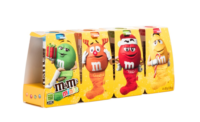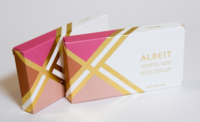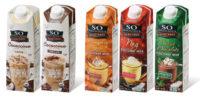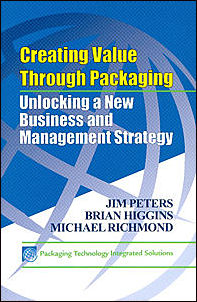New Angles in Folding Cartons

New Angles in Folding Cartons
Nifty shapes redefine paperboard packaging. Intriguing tactile finishes encourage consumers to pick up and feel the ‘box.’
by Kate Bertrand
Across various consumer goods categories, brand owners are exploring nontraditional shapes for their paperboard packaging. Meanwhile, many are incorporating “touch-friendly” textures that encourage consumers to pick up the packages.
“Our customers are really asking for on-shelf differentiation and enhanced shelf impact for their products, and many times that involves different and new shapes for their product packaging,” says Tony Hancock, Director of Packaging Innovations for Smurfit-Stone Container Corp.
Original Gourmet cookies, for example, chose a carton design in which one front edge has given way to curved scores that create a surfboard effect. The curved panel provides a new area for graphics and text. And the proprietary package shape, developed by Smurfit-Stone, sets the brand apart from others at retail.
Taking carton shape a step further, Edwards Pies uses an octagon-shape carton for its Harvest Pumpkin Cheesecake, Chocolate Butter Pecan Pie and other frozen pies.
Indentations in each of the carton’s four, angled corners reinforce the package’s structural strength. When stacked, the cartons are more stable than conventional cartons.
The octagonal shape also stabilizes the pie within the package, reducing product damage during distribution. The package is made of .020 SBS board. An aqueous coating on the carton protects the five-color printing. Rock-Tenn Co. developed the package for Edwards Pies.
Schwans Red Baron pizza slices come in a square carton. But packed inside the carton, beneath the product, are triangular paperboard sleeves.
At point of use, the consumer slips each slice of pizza into a sleeve and into the microwave. The sleeves, provided by Graphic Packaging International, are made of paperboard laminated to susceptor material, which enhances product browning and crisping.
Forming technologies
Paperboard forming technologies, which make a broad array of geometric and custom shapes possible, also are gaining momentum.
MeadWestvaco Packaging Resources Group, for example, is developing a method for press-forming paperboard.
Similar to plastic thermoforming, the company’s pressed tray technique uses pressure and heat to form paperboard into dual-ovenable rounds, octagonals, wedges, hearts and custom shapes. In addition, the technique can emboss the brand owner’s logo into the paperboard container.
For food applications, the paperboard is extruded with food-contact grade polyester. This material com-bination makes the tray dual-ovenable.
Rock-Tenn also has developed a press-forming technique, which it calls Formations. With this technology, the substrate is either paperboard or corrugated, extruded with PET or PMP.
Again, the finished package is dual-ovenable. Rock-Tenn can form the material into shapes ranging from seasonal icons, such as a pumpkin or a Santa, to branded characters.
“It’s all about branding. You do it through the shape and the graphics. Shaped paperboard packaging gives consumer goods companies the ability to differentiate” and create brand extensions or promotional packaging that complement the core brand, says Gary Miller, Marketing Director at Rock-Tenn.
Compared with plastic substrates, press-formed paperboard offers food companies the merchandising advantage of excellent printability. A billboard effect can be achieved without resorting to labels.
Around the bend
Shapely paperboard packages are becoming more popular in the skin-care aisle. Procter & Gamble departed from the category’s standard plastic tub when it selected a paperboard canister for its new Olay Daily Facials Intensives Lathering Pillows.
Graphic Packaging International supplies the container—from A&R North America Cekacan Div.—to P&G. The Cekacan features a rounded rectangular shape with a molded plastic closure. The supplier reverse prints a proprietary plastic film via gravure, then laminates the printed film to the paperboard. The result is a container whose crisp graphics communicate the Olay brand image.
Hershey Foods also uses rounded sides on the paperboard carton for Hershey’s Swoops chocolate slices. The slices come in three polypropylene cups, which rest in the oval-style carton.
A variety of scores in the carton achieve the rounded corners. Caraustar Industries, which designed the package structure, worked closely with a machinery maker to design packaging equipment that could automatically wrap the “blanks” around the stacked cups at acceptable production speeds.
Package graphics leverage Hershey’s equity in each sub-brand by incorporating its distinctive colors and logos.
Adding a fifth panel to a rectangular carton is another way to tweak the package’s shape. Typically, the fifth panel opens out from the front panel of the carton, like the cover of a book.
General Mills took this tack with promotional packaging for its Monsters cereals, including Frankenberry and Booberry. On each package, the fifth panel is die-cut to allow some of the graphics on the carton’s front panel to show through.
Made from recycled board, the cartons come in eight colors via web offset printing. Graphic Packaging International supplies the cartons.
A ‘crowning’ achievement
In some cases, brand owners are updating the package’s shape by adding a surprising top to a rectangular or square carton. The package for Nestlé’s Perugina Biscotti, for example, features an artful combination of flaps that form an origami-style dome with a “peek-a-boo” presentation of foil.
“The Perugina brand is a high-end premium chocolate biscotti. We wanted the packaging to communicate that. It’s why we went to the extra effort with the packaging,” says Brad Rose, Marketing Manager, Nestlé Specialty Confections.
He adds that the flaps are easily closed, manually, on the packaging line: “It looks complicated, but it goes together quite easily.” Impress Communications designed, printed, foil-stamped and die-cut the biscotti package.
Several other brand owners are integrating a gable-top look for their paperboard packages. The result is a carton that looks like a pouch—a very popular structure in today’s retail environment. But the carton offers more structural integrity than a pouch made from flexible materials.
Chocolate-covered fruit marketed under the Queen Anne and Harvest Sweets brands come in cartons with a gabled top edge.
In the hair-care aisle, secondary packaging for Aquage, A Gift From the Sea, includes a paperboard carton with a bag-closure top tuck and gable sidewalls. Caraustar created the Queen Anne and Aquage packaging.
Microwave popcorn packaging is taking a new shape, too. For its Perfect Popper product, Family Time Snacks replaced the popcorn cook-in bag with an innovative paperboard carton.
A pouch of microwave popcorn adheres to the inside of the carton. The consumer pops up the carton and microwaves the product. The carton fills up, the consumer peels back the lidding material, and the carton acts as a serving bowl. Smurfit-Stone Container created the new package.
A true brand ‘touchpoint’
Complementing the many new shapes are a range of surface finishes. Increasingly, paperboard packaging for items such as personal-care products, fragrances, CDs, DVDs and gourmet foods are incorporating textures that simulate materials such as metal, suede, wood and fabric.
“There is more demand for texturized surfaces. I hear this often,” says Rick Plaut, Director of Sales and Marketing at FiberMark Inc. “Making the package feel different invites the consumer to pick it up. The marketing-savvy companies know that once you pick up the package, there’s a really good chance it will fall into your shopping basket.”
Universal Studios, for its Scarface DVD gift set, chose a textured surface that is embossed to look and feel like black reptile skin. The material gives the box a high-end, dangerous, masculine appearance that resonates with the movie’s theme.
On the inside of the box, a red satin-like lining showcases the two-disc anniversary edition of the film. The Scarface package, cre-ated by Shorewood Packaging, is made using textured materials supplied by FiberMark.
In the teeth-whitening cate-gory, the package for a whitening pen from BriteSmile To Go feels like finely woven silk. The product carries a suggested retail price of $29.95 and is available through high-end department stores, dental offices and BriteSmile Spas.
Because of the premium positioning, the package needed to convey an upscale visual and tactile impression. BriteSmile opted for an actual pen box, covered with iridescent-blue material from FiberMark. The result is a silky, elegant package.
Embossing with a twist
Several brand owners have opted to treat part or all of a paperboard carton via embossing.
For its Lacoste Pour Homme fragrance, Procter & Gamble embosses a piqué pattern on the entire carton. Printing the embossed marks, using tightly registered lithography, accentuates the pattern.
“It is a very masculine looking box,” says Matt Unger, Section Head, Corporate Functions R&D, Procter & Gamble. “The decorations reinforce the Lacoste brand by replicating the texture of the weave the company uses for its clothing products. It’s a well thought out, well executed design.”
Unger adds that texture “accentuates the message a brand is trying to make. In addition to making a visual impression, embossing lets a brand make a tactile impression. You can feel it.”
Similarly, Top Flite Golf Co. introduced its Ben Hogan The Hawk line of golf balls in a package with embossing in a herringbone pattern.
The lid to the 12-pack box carries the texture, as do the four sleeves of golf balls inside the package. The carton’s metallized surface “catches” the light, accentuating the embossed pattern.
Caraustar does the printing, embossing and die-cutting for the package.
Godiva Chocolatier chose to emboss only part of the carton for its Caramel Nouveau candies. The package incorporates an embossed pattern on copper-tinted foil, which accents the company’s familiar gold-foiled board. The copper section is embossed with an intricate pattern of dots and swirls.
“The graphics and embossing leverage Godiva’s brand identity, but is a departure from the familiar gold packaging,” says Dennis Bacchetta, Marketing Manager at Diamond Packaging.
Diamond manufactures the Caramel Nouveau package. BP
The author, Kate Bertrand, is a San Francisco-based writer specializing in packaging, business and technology. Contact her at kate.bertrand@sbcglobal.net
COOL PACKAGE FOR A HOT SOUND
Textured packaging helped Ani DiFranco’s Evolve CD win a 2004 Grammy for Best Recording Package. The package’s slipcase uses a paperboard laminate that looks like blue metal but feels like wood grain.
Musical innovator DiFranco co-designed the package with designer Brian Grunert.
Die-cutting on the slipcase reveals the name of the CD and the embossed image of a moth on the inner package. The artist’s name and listing of song titles are flat stamped in black on the slipcase.
For contrast, the inner package uses the uncoated side of SBS board with multi-color printing.
The slipcase’s exterior surface uses FiberMark’s Skivertex Alloy, and embossed material with a brush finish. This fiber-based material laminates onto 12-point black matte board.
Shorewood Packaging did the die-cutting, foil-stamping and registered embossing for the package.
“In an age where you can download any song, one way to stay relevant is to make the CD packaging an experience unto itself,” says Grunert. “The first line of defense is how it looks at retail. Does it look like it’s worth $15 when I know I can get it for free online?”
Thus, the package for the Evolve CD “gives you a reward for having bought it,” Grunert explains.
SINGLE-SERVE PACK EXUDES ‘PYRAMID POWER’
As AMES International planned the launch of its Teaosophy line of premium teas, it faced an unusual branding challenge: How to communicate that its tea comes in pyramid-shaped “tea pods” instead of tea bags.
Marketing the product through hotels and restaurants became a key piece of the branding and communications strategy. For foodservice, the company packages the Teaosophy tea pods in pyramid-shaped cartons, with one tea pod per carton.
“One reason we decided to go into the restaurant and hotel market was to get consumers to understand this concept and to build the brand experience,” says Amy Paulose, Vice President, AMES International Tea Division, Fife, Wash.
Each triangular carton carries information about the tea variety (Darjeeling, Ceylon, Nilgiri, Assam or Kerala) and the part of India or Sri Lanka where the tea is grown. Color-coding the cartons helps to distinguish the tea variety.
“There is info about the tea pod, the leaf, where the tea comes from,” Paulose says. “It builds that brand experience, brand recognition and brand loyalty, and we believe that will drive retail sales.”
Because of shelf-space constraints, the retail packaging for Teaosophy is a standard rectangular folding carton. A PET caddy filled with 16 tea pods nests inside the carton.
Looking for a reprint of this article?
From high-res PDFs to custom plaques, order your copy today!








